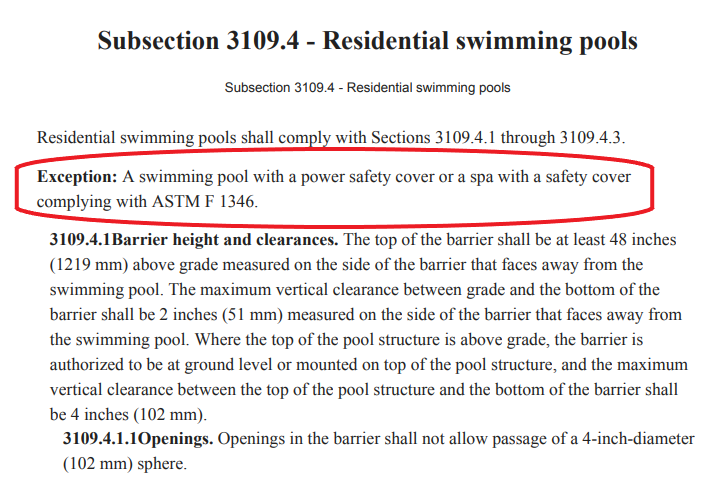Although drowning is the leading cause of death for all children in the United States, research indicates that children with autism are at an increased risk due to sensory issues, impulsivity, and lack of understanding of danger. Therefore, it is essential to take steps to prevent drowning incidents from occurring in all swimming pools whether the pool owner has a child or not.
The best prevention method for all children is installing a barrier surrounding the swimming pool that meets Consumer Product Safety Commission standards. However, this fencing becomes more crucial in drowning prevention when we are looking at the life of a child on the autism spectrum. In this article, we will explore this method of drowning prevention and the Residential Pool Code that took it away.
Drowning is the cause of death for almost 3 in 4 children with autism who wander off alone.
Reinforce water and swimming safety. Home swimming pools should be surrounded by a fence that prevents a child from getting to the pool from the house. There is no substitute for a four-foot-high, non-climbable, four-sided fence with a self-closing, self-latching gate; some states require at least 5 feet.
Susan Hyman, MD, FAAP & Lori McIlwain, Keep Kids with Autism Safe from Wandering: Tips from the AAP, healthychildren.org
A barrier fence surrounding the swimming pool is a physical barrier that meets Consumer Product Safety Commission standards, which specify the height, strength, and materials used in the barrier’s construction. It can be made of various materials, such as wood, vinyl, or aluminum. The fence must also have a self-closing and self-latching gate that opens away from the pool area.
The benefits of a barrier surrounding the swimming pool are clear, and it is an effective way to prevent children from accessing the pool area without adult supervision. The barrier’s height and strength make it difficult for children to climb over, and the self-closing and self-latching gate ensures that the pool area is secure when not in use. A barrier surrounding the swimming pool also provides peace of mind to parents and caregivers, knowing that the pool area is secure and their child is safe, but supervision is still required.
An ASTM Certified Power Safety Cover
An ASTM-certified power safety cover is a motorized cover that can be used over the pool when not used. When closed, the cover creates a physical barrier that prevents children from accessing the pool area. The cover is ASTM certified, which means it meets specific safety standards the American Society for Testing and Materials set.
The benefits of an ASTM-certified power safety cover are also evident. It provides a means of preventing child access to the pool area with or without adult supervision. The cover’s motorized system makes it easy to open and close. Unfortunately, the power safety cover is designed to collect standing water. To continue to meet the ASTM standard and not become a drowning risk, the pool owner MUST remove any standing water on the cover within thirty minutes. Sadly this is a shortcoming of this option as we are counting on the pool owner to take immediate action following every rain to keep that pool cover itself from becoming a risk.
Standing Water
Automatic cover pumps are indeed available. Unfortunately, it is not uncommon for the float that activates the pump to stick, either not running when water fills the cover or not shutting off after the water has been removed, causing the pump to overheat and burn a hole through the cover. Then, and you probably wouldn’t be aware of this unless you were a pool professional and in and out of people’s backyards daily, but these automatic cover pumps, if on the cover at all, are often left unplugged by landscapers or family members looking to use the extension cord for some other reason. This makes the cover an even greater risk, providing a false sense of security and a hazard with every rain or other precipitation.
In addition to close supervision, CPSC recommends layers of protection, including barriers, such as a fence with self-closing, self-latching gates, completely surrounding pools to prevent unsupervised access by young children. If the house forms a side of the barrier, use alarms on doors leading to the pool area or a power safety cover over the pool. It is important to always be prepared for an emergency by having rescue equipment and a phone near the pool. Also, parents should learn cardiopulmonary resuscitation (CPR).
Drowning Prevention, Consumer Products Safety Commision
Sadly, Statute writers have misinterpreted the above quote from the Consumer Product Safety Commission to read that a power safety cover may be used instead of a pool barrier/fence (see below). The CPSC recommends adding a power safety cover as an add-on if a safety barrier/fence is already in place and only in cases where the house is one side of the four-sided safety barrier. This, of course, to ensure the protection of the child living in that home that could open an exterior door into the pool area. The fencing itself, if three-sided, with the house as the fourth side of the barrier, prevents access to any child in the neighborhood who might wander into a yard with a pool.

Even though this does not match the CPSC recommendation, it probably still looks good on paper to those individuals who drafted the code and the lawmakers that have adopted it. The problem is that the code’s authors again rely on pool owner compliance. This cover only meets the ASTM standard, which the IRC (International Residential Code) above states is a must, if the pool owner recovers the pool following every use.
International Residential Code
The same holds for latching spa safety covers. These covers do not meet the ASTM standard above that the IRC states is a must unless it is on and latched when not used. In my thirty-plus years of experience as a pool industry consultant and former swimming pool service company owner, I have never arrived at a customer’s house and found the power cover, if installed, to be closed. On the other hand, latching spa covers are often in place on top of the spa but never latched. The scary part is that at this point, the International Code Council boasts a whopping 49 states have adopted all or part of their IRC that contains the exception as is written above.
similar article CMAHC’s Dewey Case Discusses Importance of Virginia Graeme Baker Pool & Spa Safety Act
Both a barrier completely surrounding the swimming pool and an ASTM-certified power safety cover are effective methods of preventing drowning incidents. However, the clear winner is a barrier completely surrounding the swimming pool that meets Consumer Product Safety Commission standards. A barrier completely surrounding the swimming pool is also less likely to have mechanical failures. It does not require electricity to operate, which can be vital during power outages or in remote areas where electricity may not be readily available. An ASTM-certified power cover is an excellent add-on, but in my opinion, falls short.
Teach Your Child to Swim
Swimming lessons for children with special needs are available at many YMCA locations. The final lesson should be with clothes on. Remember: teaching your child how to swim does not mean your child is safe in water. If you own a pool, fence it and if neighbors have pools, let them know of these safety precautions and your child’s tendency to wander. Remove all toys or items of interest from the pool when not in use.
From AWAARE: Autism Wandering Awareness Alerts Response Education Coalition, Six Tips to Help Prevent Wandering and Wandering-Related Tragedies
In conclusion, preventing drowning incidents involving children on the autism spectrum requires careful consideration of the best prevention methods. While an ASTM-certified power safety cover can be a great add-on to our layers of protection, a barrier completely surrounding the swimming pool that meets Consumer Product Safety Commission standards offer superior protection when installed by a professional with a self-closing/self-latching gate. It provides a physical barrier that is always in place, ensuring that the pool area is secure and that children are safe. If you are concerned as I am, please contact your Senator or Legislator and demand the removal of the exceptions to the barrier requirement from your State, County, or Town’s Residential Building Code.






